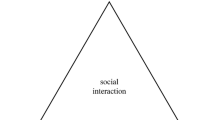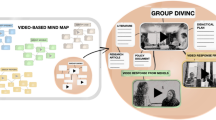Abstract
This study examines visitors’ use of two different electronic guidebook prototypes, the second an iteration of the first, that were developed to support social interaction between companions as they tour a historic house. Three studies were conducted in which paired visitors’ social interactions were video- and audio-recorded for analysis. Using conversation analysis, the data from the use of prototype 1 and prototype 2 were compared. It was found that audio delivery methods were consequential to the ways in which visitors structurally organized their social activity. Further, the availability of structural opportunities for social interaction between visitors has implications for the ways in which the learning process occurs in museum settings.








Similar content being viewed by others
Notes
This is not to say that learning simply equates with language use. However, learning occurs in part through social interaction, and we can observe learning processes by observing aspects of social interaction such as “learner articulation” (Koschmann and LeBaron 2002).
Since our focus in this paper is on social interaction rather than the technological aspects of the guidebook itself, we limit our system descriptions to a level of detail sufficient to understand the study findings. Schwarzer (2001) provides substantial background information about electronic guidebooks.
For example, the 20 s description of a portrait of the Duchess of Richmond and Lennox reads:
This 17th century portrait shows the Duchess of Richmond and Lennox, about whom Pepys said in his diary, ‘Never had a woman more beauty nor less wit.’ The portrait was done by Sir Peter Lely, who was the first of the great English portrait painters. Lely created the distinctive look of British portraiture, including the three-quarter pose and the emphasis on beautiful clothing.
While several children participated in the first and second studies, public visitors from the ages of approximately 5–17 are quite rare at Filoli unless they are visiting with a school group.
We use “shared listening” to describe the organization of the visitors’ activity. It does not imply that the visitors focused their attention exclusively on the audio descriptions during the entire visit, nor that we can assert that one companion in a pair heard every sound heard by the other. However, as suggested by the excerpts in Section 4, a shared audio context was widely achieved, and Section 5.1 gives further detail about how this came about.
References
Allen, S. (2002): Looking for Learning in Visitor Talk: A Methodological Exploration. In G. Leinhardt, K. Crowley and K. Knutson (eds): Learning Conversations in Museums. Mahwah, NJ: Lawrence Erlbaum, pp. 259–303.
Aoki, P.M. and A. Woodruff (2000): Improving Electronic Guidebook Interfaces Using a Task-Oriented Design Approach. In Proc. ACM Conference on Designing Interactive Systems. New York: ACM, pp. 319–325.
Aoki, P.M., A. Hurst and A. Woodruff (2001): Tap Tips: Lightweight Discovery of Touchscreen Targets. In Extended Abstracts, ACM SIGCHI Conference on Human Factors in Computing Systems. New York: ACM, pp. 237–238.
Aoki, P.M., R.E. Grinter, A. Hurst, M.H. Szymanski, J.D. Thornton and A. Woodruff (2002): Sotto Voce: Exploring the Interplay of Conversation and Mobile Audio Spaces. In Proc. ACM SIGCHI Conference on Human Factors in Computing Systems. New York: ACM, pp. 431–438.
Atkinson, J.M. and J. Heritage (eds.) (1984): Structures of Social Action. Cambridge: Cambridge University Press.
Brown, B., I. MacColl, M. Chalmers, A. Galani, C. Randell and A. Steed (2003): Lessons from the Lighthouse: Collaboration in a Shared Mixed Reality System. In Proc. ACM SIGCHI Conference on Human Factors in Computing Systems. New York: ACM, pp. 577–584.
Bruner, J. (1986): Actual Minds, Possible Worlds. Cambridge, MA: Harvard University Press.
Bruner, J. (1990): Acts of Meaning. Cambridge, MA: Harvard University Press.
Dudley-Marling, C. and D. Searle (1991): When Students Have Time to Talk: Creating Contexts for Learning Language. Portsmouth, NH: Heinemann.
Falk, J.H. and L.D. Dierking (1992): The Museum Experience. Washington, DC: Whalesback.
Falk, J.H. and L.D. Dierking (2000): Learning From Museums. Walnut Creek, CA: Altamira.
Goffman, E. (1981): Footing. In E. Goffman (ed): Forms of Talk. Philadelphia, PA: University of Pennsylvania Press, pp. 124–159.
Goldberg, J. (1975): A System for the Transfer of Instructions in Natural Settings. Semiotica, vol. 14.3, pp. 269–296.
Goodwin, C. (1981): Notes on the Organization of Engagement. In C. Goodwin (ed): Conversational Organization: Interaction Between Speakers and Hearers. New York: Academic, pp. 95–125.
Goodwin, C. and M.H. Goodwin (1992): Context, Activity, and Participation. In P. Auer and A. Di Luzio (eds): Contextualization of Language. Amsterdam: John Benjamins, pp. 77–99.
Grinter, R.E., P.M. Aoki, A. Hurst, M.H. Szymanski, J.D. Thornton and A. Woodruff (2002): Revisiting the Visit: Understanding How Technology Can Shape the Museum Visit. In Proc. ACM Conf. on Computer Supported Cooperative Work. New York: ACM, pp. 146–155.
Gutierrez, K. (1995): Unpackaging Academic Discourse. Discourse Processes, vol. 19, no. 1, pp. 21–37.
Heath, C., and J. Hindmarsh (2000): Configuring Action in Objects: From Mutual Space to Media Space. Mind, Culture, and Activity, vol. 7, no. 1&2, pp. 81–104.
Heath, C., and P. Luff (1992): Collaboration and Control: Crisis Management and Multimedia Technology in London Underground Line Control Rooms. Computer Supported Cooperative Work, vol. 1, no. 1. pp. 24–48.
Heath, C. and D. vom Lehn (2002): Misconstruing Interactivity. In M. Hinton (ed): Interactive Learning in Museums of Art and Design. London: Victoria & Albert Museum.
Hein, G. E. (1995): The Constructivist Museum. Journal of Education in Museums, vol. 16, pp. 21–23.
Hemmings, T., D. Randall, L. Marr and D. Francis (2000): Talk, Task and Closure: Situated Learning and the Use of an ‘Interactive’ Museum Artefact. In S. Hester and D. Francis (eds): Local Educational Order: Ethnomethodological Studies of Knowledge in Action. Amsterdam: John Benjamin.
Hensel, K.A. (1987): Families in Museums: Interactions and Conversations at Displays. Ed.D. dissertation, Columbia University Teacher’s College, New York.
Heritage, J.C. (1984a): Garfinkel and Ethnomethodology. Cambridge: Polity.
Heritage, J.C. (1984b): A change-of-state token and aspects of its sequential placement. In J.M. Atkinson and J. Heritage (eds): Structures of Social Action: Studies in Conversation Analysis. Cambridge: Cambridge University Press, pp. 299–345.
Hindmarsh, J., C. Heath, D. vom Lehn and J. Cleverly (2005): Creating Assemblies in Public Environments: Social Interaction, Interactive Exhibits and CSCW. Computer Supported Cooperative Work, vol. 14, no. 1, pp. 1–41.
Hood, M.G. (1983). Staying Away: Why People Choose not to Visit Museums. Museum News, vol. 61, no. 4, pp. 50–57.
Koschmann, T., and C. LeBaron (2002): Learner Articulation as Interactional Jointing: Studying Gesture Conversationally. Cognition and Instruction, vol. 20, no. 2, pp. 249–282.
Leinhardt, G., K. Crowley and K. Knutson (eds.) (2002): Learning Conversations in Museums. Mahwah, NJ: Lawrence Erlbaum.
Lerner, G.H. (1991): On the Syntax of Sentences-in-Progress. Language in Society, vol. 20, pp. 441–458.
Lerner, G. H. (1995): Turn design and the organization of participation in instructional activities. Discourse Processes, vol. 19, no. 1, pp. 111–131.
Lave, J. and E. Wenger (1991): Situated Learning: Legitimate Peripheral Participation. Cambridge: Cambridge University Press.
McManus, P.M. (1989): Oh, Yes They Do! How Museum Visitors Read Labels and Interact with Exhibit Texts. Curator, vol. 32, no. 3, pp. 174–189.
Martin, D. (2000): Audio Guides. Museum Practice, vol. 5, no. 1, pp. 71–81.
Moll, L.C. (ed.) (1990): Vygotsky and Education: Instructional Implications and Applications of Sociohistorical Psychology. Cambridge: Cambridge University Press.
Resnick, L.B., J.M. Levine and S.D. Teasley (eds.) (1991): Perspectives on Socially Shared Cognition. Washington, DC: American Psychological Association.
Russell, T. (1994): The Enquiring Visitor: Usable Learning Theory for Museum Contexts. Journal of Education in Museums, vol. 15, pp. 19–21.
Sacks, H. (1974): An Analysis of the Course of a Joke’s Telling in Conversation. In R. Bauman and J. Sherzer (eds.): Explorations in the Ethnography of Speaking. Cambridge: Cambridge University Press, pp. 337–353.
Sacks, H., E.A. Schegloff and G. Jefferson (1974): A Simplest Systematics for the Organization of Turn-Taking for Conversation. Language, vol. 50, pp. 696–735.
Schegloff, E.A. (1982): Discourse as an Interactional Achievement: Some Uses of ‘uh huh’ and Other Things That Come Between Sentences. In D. Tannen (ed): Analyzing Discourse: Text and Talk. Washington, DC: Georgetown University Press, pp. 71–93.
Schegloff, E.A. (1992): Repair After Next Turn: The Last Structurally Provided Place for the Defense of Intersubjectivity in Conversation. American Journal of Sociology, vol. 95, pp. 1295–1345.
Schegloff, E.A. (2000): Overlapping Talk and the Organization of Turn-Taking for Conversation. Language in Society, vol. 29, pp. 1–6.
Schegloff, E. A. and H. Sacks (1973): Opening Up Closings. Semiotica, vol. 8, pp. 289–327.
Schwarzer, M. (2001): Art & Gadgetry: The Future of the Museum Visit. Museum News, July/August, pp. 36–41.
Szymanski, M.H. (1999): Re-engaging and Dis-engaging Talk in Activity. Language in Society, vol. 28, no. 1, pp. 1–23.
Tharp, R.G., and R. Gallimore, (1988): Rousing Minds to Life: Teaching, Learning, and Schooling in Social Context. Cambridge: Cambridge University Press.
vom Lehn, D., C. Heath and J. Hindmarsh (2001): Exhibiting Interaction: Conduct and Collaboration in Museums and Galleries. Symbolic Interaction, vol. 24, no. 2, pp. 189–216.
vom Lehn, D., C. Heath and J. Hindmarsh (2002): Video Based Field Studies in Museums and Galleries. Visitor Studies Today, Fall/Winter, pp. 15–23.
Vygotsky, L.S. (1986): Thought and Language. Cambridge, MA: MIT.
Wertsch, J.V. (1991): Voices of the Mind: A Sociocultural Approach to Mediated Action. Cambridge, MA: Harvard University Press.
Woodruff, A., M.H. Szymanski, P.M. Aoki and A. Hurst (2001): The Conversational Role of Electronic Guidebooks. In Proc. International Conference on Ubiquitous Computing. Berlin: Springer, pp. 187–208.
Acknowledgements
We are deeply grateful to Tom Rogers and Anne Taylor of Filoli Center for their assistance with this project. We also thank Tom for his perceptive comments on the design of the prototype; Bob Moore, Mark Newman, Morgan Price, Peter Putz, Terkel Skaarup, Ian Smith, Michaele Smith, Erik Vinkhuyzen, and Marilyn Whalen for helpful insights; Maribeth Back for assistance in recording the Study 1 audio clips; and Shane Nye for editing the Study 2 audio and video data. Amy Hurst performed this work during two internships from the College of Computing, Georgia Institute of Technology. This work was funded by the Computer Science Laboratory of the Palo Alto Research Center.
Author information
Authors and Affiliations
Corresponding author
Rights and permissions
About this article
Cite this article
Szymanski, M.H., Aoki, P.M., Grinter, R.E. et al. Sotto Voce: Facilitating Social Learning in a Historic House. Comput Supported Coop Work 17, 5–34 (2008). https://doi.org/10.1007/s10606-007-9067-y
Received:
Published:
Issue Date:
DOI: https://doi.org/10.1007/s10606-007-9067-y




